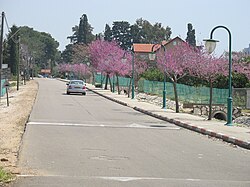Liman, Israel
Liman
| |
|---|---|
 | |
| Coordinates: 33°3′32.39″N 35°6′46.44″E / 33.0589972°N 35.1129000°E | |
| Country | Israel |
| District | Northern |
| Council | Mateh Asher |
| Affiliation | Moshavim Movement |
| Founded | 1949 |
| Founded by | Demobilized soldiers |
| Population (2022)[1] | 684 |
Liman (Template:Lang-he-n) is a moshav in northern Israel. Located in the Western Galilee about 5 km (3 mi) north of Nahariya, it falls under the jurisdiction of Mateh Asher Regional Council. In 2022 it had a population of 684.[1] Its area is about 2400 dunams and most residents work in agriculture, including chicken raising.
History
The village was founded in 1949 by a group of demobilized soldiers on part of the lands of the depopulated Palestinian village of al-Bassa. It was originally called Tzahal,[2][3] but was later renamed "Liman" to honor the American senator Herbert H. Lehman.
The Liman Nature Reserve is located about 1 km (1 mi) north of the settlement, an area of about 50 dunams on a section of the gravel ridge that was preserved.
A 3rd century painted tomb from the Roman period was discovered in the fields of Liman in 1994–1995. The tomb contained two skeletons, bottles, coins and pottery.[4]
References
- ^ a b "Regional Statistics". Israel Central Bureau of Statistics. Retrieved 21 March 2024.
- ^ Morris, Benny (2004). The Birth of the Palestinian Refugee Problem Revisited. Cambridge University Press. p. xxii. ISBN 978-0-521-00967-6.
- ^ Khalidi, Walid (1992). All That Remains: The Palestinian Villages Occupied and Depopulated by Israel in 1948. Washington D.C.: Institute for Palestine Studies. p. 9. ISBN 0-88728-224-5.
- ^ Tombs of the Roman Period at Tell Shubeib
External links
- Liman Association for the Development of the Galilee

